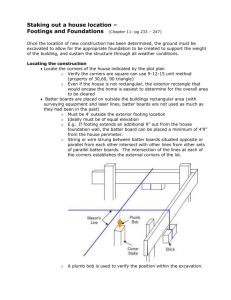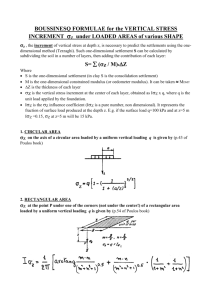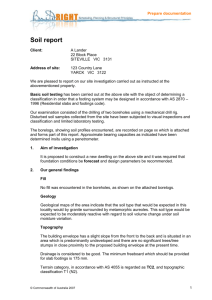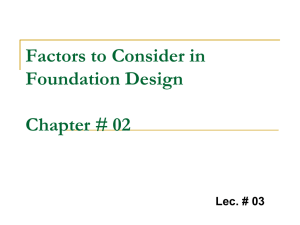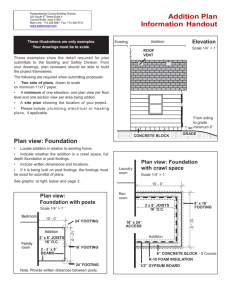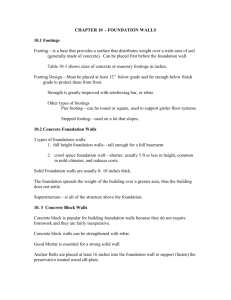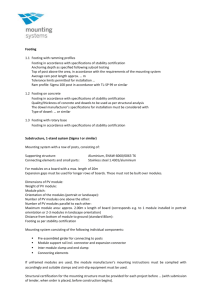CE Steel Design Review
advertisement
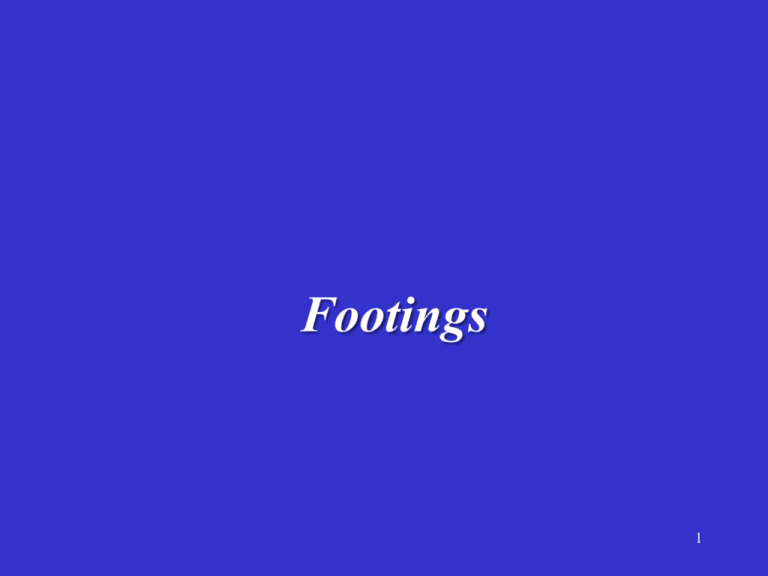
Footings 1 Acknowledgement This Powerpoint presentation was prepared by Dr. Terry Weigel, University of Louisville. This work and other contributions to the text by Dr. Weigel are gratefully acknowledged. 2 Footings Support structural members and transfer loads to the soil Structural members are usually columns or walls Design for load transfer to soil uses unfactored loads Structural design of footing is done with factored loads 3 Footings Footings must be designed to prevent bearing failure, sliding and overturning Footings must be designed to prevent excessive settlement or tilting Typically, bottom of footing must be located below frost line Excavation may be required to reach a depth where satisfactory bearing material is located 4 Wall Footing Wall footings – enlargement of the bottom of the wall 5 Isolated Square Footing Isolated or single column square footing – loads relatively light and columns not closely spaced 6 Combined Footing Combined footings – support two or more columns – heavily loaded columns; closely spaced columns; columns near property line 7 Mat Footing Mat or raft foundation – continuous concrete slab supporting many columns; soil strength relatively low; large column loads; isolated spread footings would cover more than 50 percent of area; reduce differential settlement 8 Pile Cap Pile caps – distribute column loads to groups of piles 9 Soil Pressure Soil pressure is assumed to be uniformly distributed beneath footing if column load is applied at the center of gravity of the footing Footings supported by sandy soils Footings supported by clayey soils Footings supported eccentric loads 10 Assumed Soil Pressure 11 Soil Pressure - Sandy Soil 12 Soil Pressure - Clayey Soil 13 Allowable Soil Pressure Actual soil pressure is based on unfactored loads Allowable soil pressure may be determined by a geotechnical engineer When soil exploration is not feasible, values provided by building codes may be used Factor of safety is typically 3 14 Allowable Soil Pressure (Table 12.1) Maximum Allowable Soil Pressure Material Rock Allowable Pressure, ksf 20% of ultimate strength Compact coarse or fine sand, hard clay or sand clay 8 Medium stiff clay or sandy clay 6 Compact inorganic sand and silt mixtures 4 Loose sand 3 Soft sand clay or clay 2 Loose inorganic sand-silt mixtures 1 Loose organic sand-silt mixtures, muck or bay mud 0 15 Design of Wall Footings Generally, beam design theory is used Shear strength almost always controls footing depth Compute moment at the face of the wall (concrete wall) or halfway between wall face and its centerline (masonry walls) 16 Design of Wall Footings 17 Design of Wall Footings 18 Design of Wall Footings 19 Design of Wall Footings 20 Design of Wall Footings Shear may be calculated at distance d from face of the wall Use of stirrups is not economical – set d so that concrete carries all the shear Vc 2 f c' bw d d Vu 2 f c' bw 21 Design of Wall Footings Design a 12-in wide strip Section 15.7 of ACI Code: Depth of footing above bottom reinforcement not less than 6 in for footings on soil and not less than 12 in for footings on piles Minimum practical depth of footing is 10 in and 16 in for pile caps 22 Wall Footing Design Examples 23 Example 12.1 Design a wall footing to support a 12-in. wide reinforced concrete wall with a dead load of 20 k/ft and a live load of 15 k/ft. The bottom of the footing is to be 4 foot below final grade, the soil weighs 100 lb/ft3 the allowable soil pressure is 4 ksf. The concrete strength is 3,000 psi and the steel is Grade 60. 24 Example 12.1 25 Example 12.1 Assume a footing thickness of 12 in. With a minimum cover of 3 in., this gives a d value of about 8.5 in. Compute the footing weight and Footing weight soil weight: 12 in 150 150 psf 12 in/ft Soil weight 36 in 100 300 psf 12 in/ft 26 Example 12.1 Effective soil pressure and required width of footing: qe 4000 psf 150 psf 300 psf 3550 psf Width of footing required 20 k/ft 15 k/ft 9.86 ft 3.55 ksf Use 10 ft 27 Example 12.1 Factored bearing pressure for design of concrete: qu 1.2 20 k/ft 1.6 15 k/ft 10 ft 4.80 ksf 28 Example 12.1 Compute design shear (at distance d from face of wall): 6 in 8.5 in 10 ft Vu 4.80 ksf 18.2 k 12 in/ft 12 in/ft 2 18, 200 lb d 18.46 in 0.75(1.0) 2 3000 ksi 12 in Much larger than orginal assumption Try a thicker footing - say 20 in thick d 16.5 in 29 Example 12.1 20 in qe 4000 psf 150 psf 12 in/ft 28 in 100 psf 3517 psf 12 in/ft Width of footing required 20 k/ft 15 k/ft 9.95 ft 3.517 ksf Use 10 ft 30 Example 12.1 6 in 16.5 in 10 ft Vu 4.80 ksf 15.0 k 12 in/ft 12 in/ft 2 15,000 lb d 15.21 in 0.75 2 3000 ksi 12 in/ft h 15.21 in 3.5 in 18.71 in Use a 20 in thick footing 31 Example 12.1 10 ft 6 in 4.5 ft 2 12 in/ft Compute moment on a one-foot-long strip wL 4.80 k/ft 4.5 ft Mu 48.6 k-ft/ft 2 2 12 in/ft 48, 600 lb-ft/ft Mu 198.3 psi 2 2 bd 0.9 12 in 16.5 in 2 2 32 Example 12.1 Appendix Table 4.12, r = 0.00345 < 0.0136, section is tension controlled; = 0.9 2 in As 0.0034512 in 16.5 in 0.68 ft Use No 7 at 10 in (As = 0.72 in2 / ft from Table A.6) 33 Example 12.1 Development length: t e s 1 cb 5 in side cover db 0.875 3.4375 use cb 3.5 in cb 3 3 2 2 10 in 5 in one-half c-c spacing of bars cb 2 cb K tr 3.5 in 0 4.0 Use 2.5 0.875 in db 34 Example 12.1 3 f y t e s ' d b 40 f c cb K tr db d 3 60,000 psi 1 32.86 diameters 40 3000 psi 2.5 2 A 0.68 in /ft s ,required d 32.86 31.03 diameters 2 d b As , provided 0.72 in /ft d 31.03 0.875 in 27.15 in 35 Example 12.1 Available length for development 10 ft 12 in/ft 6 in 3 in 51 in 27.15 in 2 36 Example 12.1 Temperature and shrinkage steel As 0.0018 12 in 20 in 0.432 in 2 / ft Use No 5 at 8 in (As = 0.465 in2 / ft) 37 Design of Isolated Square Footings Most isolated square footings have a constant thickness For very thick footings, it may be economical to step or taper footing Two types of shear must be considered – oneway shear and two-way shear 38 Design of Isolated Square Footings Constant thickness 39 Design of Isolated Square Footings Stepped 40 Design of Isolated Square Footings Tapered 41 One-way Shear Same as for wall footings d Vu 2 f c' bw 42 One-way Shear 43 Two-way Shear ACI Code Section 11.11.1.2 states that critical section is at a distance d/2 from face of support 44 Two-way Shear 45 Two-way Shear 46 Two-way Shear Vc 4 f c' bo d <- ACI Code Equation 11-33 4 Vc 2 f c' bo d <- ACI Code Equation 11-35 c c ratio of the length of the long side of the column to the length of the short side of the column bearing on the footing sd ' Vc 2 f c bo d <- ACI Code Equation 11-34 bo 47 Two-way Shear s = 40 for interior columns s = 30 for exterior columns s = 20 for corner columns 48 Flexural Design – Isolated Square Footings Flexural reinforcement is required in two directions The values of d for the layers of steel in the two directions will be different For square footings, design using the value of d for the upper layer is typical For square footings supporting non-square columns, moments are larger in the shorter direction of the column 49 Flexural Design – Isolated Square Footings Reinforcing steel areas required to resist moment are often less than minimum required steel: 200 As ,min As ,min fy bw d 3 f c' fy bw d Code Section 10.5.4 states that minimum area and maximum spacing need only be equal to values required for temperature and shrinkage steel 50 Flexural Design – Isolated Square Footings Maximum steel spacing may not exceed three times the footing thickness or 18 in. 51 Load Transfer from Column to Footing All forces at the base of the column must be transferred to the footing Compressive forces must be transferred by bearing Tensile forces may be transferred by reinforcement or mechanical connectors 52 Load Transfer from Column to Footing Columns transfer loads directly over the area of the column Load transfer into the footing may by assumed to occur over an effective area which may be larger than the column area For the same strength of concrete, the footing can support more bearing load than can the column 53 Load Transfer from Column to Footing Bearing strength permitted at the base of the column -> 0.85 f c' A1 Bearing strength permitted on the footing is the same value multiplied by -> A2 A1 2 See ACI Code Section 10.14.1 54 Definition of A1 and A2 A1 is the area of the column A2 is the area of footing geometrically similar to and concentric with the column 55 Column Dowels 56 Excess Bearing Load Excess bearing load can be carried by dowels or column bars extended into footing ACI Code Section 15.8.2 requires that the dowel area not be less than 0.005 times the gross cross-sectional area of the column 57 Development Length for Dowels Development length of dowels must be sufficient to transfer column force to footing Development length of dowels may not be less than the length required if bearing stress was not exceeded 58 Splice Length for Dowels ACI Code does not permit splicing of No 14 or No 18 bars ACI Code Section 15.8.2.3 does permit No 14 or No 18 bars to be spliced to No 11 (or larger) dowels in footings These dowels must extend into the column not less than the development length for the No 14 or No 18 bar, or the compression lap splice length for the dowels, whichever is larger 59 Splice Length for Dowels These dowels must extend into the footing for a distance not less than the development length for dowels 60 Insufficient Development or Splice Length Use a larger number of smaller dowels Use a deeper footing Add a cap or pedestal to the footing 61 Column Uplift Development length must be those for tension Splice requirements are those found in ACI Code Section 12.17 62 Isolated Rectangular Footings Square footings are more econonical than rectangular footings Long direction steel is uniformly distributed along short direction Short direction steel is non uniformly distributed along long direction 63 Isolated Rectangular Footings ACI Code Section 15.4.4.2 Reinforcement in band width 2 Reinforcement in short direction 1 is the ratio of the length of the footing in the long direction to the length in the short direction Remaining steel is distributed uniformly throughout the two portions of the footing outside the band 64 Isolated Rectangular Footings 65 Footing Design Examples 66 Example 12.2 Design a square column footing for a 16-in. square tied interior column that supports loads of D = 200 k and L = 160 k. The column is reinforced with eight No 8 bars, the bottom of the footing is 5 foot below final grade, the soil weighs 100 lb/ft3 the allowable soil pressure is 5 ksf. The concrete strength is 3,000 psi and the steel is Grade 60. 67 Example 12.2 Assume a footing thickness of 24 in. with a minimum cover of 3 in., this gives a d value of about 19.5 in. Compute the footing weight and Footing weight soil weight: 24 in 150 300 psf 12 in/ft Soil weight 36 in 100 300 psf 12 in/ft 68 Example 12.2 Effective soil pressure and required area of footing: qe 5000 psf 300 psf 300 psf 4400 psf 200 k 160 k A 81.82 ft 2 4.40 ksf Use 9 ft x 9 ft 69 Example 12.2 Factored bearing pressure for design of concrete: qu 1.2 200 k 1.6 160 k 81 ft 2 6.12 ksf 70 Example 12.2 Depth required to resist punching shear: bo 4(16 19.5) 142 in Vu 2 81.0 ft 2.96 ft d 2 2 6.12 442.09 k 442, 090 lb 0.75 4 3000 psi 142 in 18.95 in 19.5 in Ok 442, 090 lb d 40 19.5 in 0.75 2 3000 psi 142 in 142 in 10.12 in 19.5 in Ok 71 Example 12.2 72 Example 12.2 Depth required to resist one-way shear: Vu1 9 ft 2.208 ft 6.12 ksf 121.62 k d 121, 620 lb 0.75 2 3000 psi 108 in 13.71 in 19.5 in Ok 73 Example 12.2 Flexural design wL 6.12 ksf 9 ft 3.83 ft Mu 404 k-ft 2 2 12 in/ft 404, 000 lb-ft Mu 131.2 psi 2 2 bd 0.9 108 in 19.5 in 2 2 74 Example 12.2 Appendix Table 4.12, r = 0.00225 < rmin 200 r 0.0033 60, 000 psi 3 3000 psi r 0.00274 60, 000 psi As 0.0033108 in 19.5 in 6.95 in 2 Use nine No 8 (As = 7.07 in2) 75 Example 12.2 Development length: t e s 1 cb bottom cover 3.5 in cb one-half center-to-center bar spacing 6 in cb Ktr 3.5 in 0 3.5 Use 2.5 db 1.0 in 76 Example 12.2 3 f y t e s ' db 40 f c cb K tr db d 3 60, 000 1 32.86 diameters 40 3000 2.5 2 A 6.95 in s , required d 32.30 diameters 32.86 2 db As , provided 7.07 in d 32.30 1.0 in 32.30 in 77 Example 12.2 Available length for development 9 ft 12 in/ft 16 in 3 in 43 in 32.30 in 2 2 78 Example 12.3 Design for load transfer for the column and footing in Example 12.2. The strength of the sand-lightweight concrete (different from Example 12.2) in the column is 4 ksi. 79 Example 12.3 Bearing force at the column base: 1.2 200 k 1.6 160 k 496 k Design bearing force at the column base: 0.85 f A1 0.65 0.85 4 ksi 16 in ' c 2 566 k 496 k Ok 80 Example 12.3 Design bearing force in the footing concrete: 108 in 2 16 in 2 6.75 Use 2 0.85 f A1 ' c A2 A1 0.65 0.85 3 ksi 16 in 2 2 848.6 k 496 k Ok Minimum dowel area: 0.005 16 in 1.28 in 2 2 81 Example 12.3 Dowel development length into the column d 0.02db f y f c' 0.02 0.75 in 60, 000 psi 0.85 4000 psi 16.74 in Dowel development length into the footing d 0.02db f y f c' 0.02 0.75 in 60, 000 psi 1.0 3000 psi 16.43 in 82 Example 12.3 Development length must not be less than: d 0.0003db f y 0.0003 0.75 in 60, 000 ksi 13.50 in d 8.0 in 83 Example 12.4 Design for load transfer for a 14-in. square column to a 13 ft square footing if Pu = 800 k. Normal weight concrete is used in both the column and the footing. The concrete in the column is 5 ksi and in the footing is 3 ksi. The column is reinforced with eight No 8 bars. 84 Example 12.4 Bearing force at the column base = 800 k Design bearing force at the column base: 0.85 f A1 0.65 0.85 5 ksi 14 in ' c 2 541.5 k 800 k No good 85 Example 12.4 Design bearing force in the footing concrete: 156 in 2 14 in 2 A2 A1 0.85 f A1 ' c 11.14 Use 2 A2 A1 0.65 0.85 3 ksi 14 in 2 2 649.7 k 800 k No good 86 Example 12.4 Design dowels to resist excess bearing force: 800 k 541.5 k 258.5 k 258.5 k As 4.79 in 2 0.9 60 k 0.005 14 in 0.98 in 2 2 Use eight No 7 bars (As = 4.80 in2) 87 Example 12.4 Dowel development length into the column 0.02db f y 0.02 0.875 in 60, 000 psi 14.85 in 1 5000 psi d 0.0003d b f y 0.0003 0.875 in 60, 000 ksi d f ' c 15.75 in d 8.0 in 88 Example 12.4 Dowel development length into the footing 0.02db f y 0.02 0.875 in 60, 000 psi 19.42 in 1.0 3000 psi d 0.0003d b f y 0.0003 0.875 in 60, 000 ksi d f c' 15.75 in d 8.0 in 89 Example 12.5 Design a rectangular footing for an 18-in. interior square column for D = 185 k and L = 150 k. The long side of the footing should be twice the length of the short side. The normal weight concrete strength for both the column and the footing is 4 ksi. The allowable soil pressure is 4000 psf and the bottom of the footing is 5 ft below grade. 90 Example 12.5 Assume a footing thickness of 24 in. with a minimum cover of 3 in., this gives a d value of about 19.5 in. Compute the footing weight and Footing weight soil weight: 24 in 150 300 psf 12 in/ft Soil weight 60-24 in 100 300 psf 12 in/ft 91 Example 12.5 Effective soil pressure and required area of footing: qe 4000 psf 300 psf 300 psf 3400 psf 185 k 150 k A 98.5 ft 2 3.40 ksf Use a footing 7'-0" x 14'-0" A 98.0 ft 2 1.2 185 k 1.6 150 k qu 4.71 ksf 2 98.0 ft 92 Example 12.5 Depth required to resist one-way shear. Take b = 7 ft. Vu1 7 ft 4.625 ft 4.71 ksf 152.49 k d 152, 490 lb 0.75 1 2 4000 psi 84 in 19.14 in h 19.14 4.5 in 23.64 in 93 Example 12.5 94 Example 12.5 Depth required to resist punching shear: bo 4 18 19.5 in 150 in Vu 2 98.0 ft 2 3.125 ft d d 415,580 lb 2 4.71 ksf 415.58 k 0.75 1 4 4000 psi 150 in 14.60 in 19.5 in Ok 415,580 lb 40 19.5 in 0.75 2 4000 psi 150 in 150 in 8.11 in 19.5 in Ok 95 Example 12.5 96 Example 12.5 Flexural design (steel in long direction) 14 ft 9 in 6.25 ft 2 12 in/ft 6.25 ft M u 6.25 ft 7 ft 4.71 ksf 643.9 k-ft 2 12 in/ft 643,900 lb-ft Mu 268.8 psi 2 2 bd 0.9 84 in 19.5 in 97 Example 12.5 Appendix Table 4.13, r = 0.00467 As 0.00467 84 in 19.5 in 7.65 in 2 Use ten No 8 (As = 7.85 in2) 98 Example 12.5 Flexural design (steel in short direction) 7 ft 9 in 2.75 ft 2 12 in/ft 2.75 ft M u 2.75 ft 14 ft 4.71 ksf 249.3 k-ft 2 12 in/ft 249,300 lb-ft Mu 52.0 psi 2 2 bd 0.9 168 in 19.5 in Too low for Table A.13 99 Example 12.5 200 r 0.0033 60, 000 psi 3 4000 psi r 0.00316 60, 000 psi As 0.0033168 in 19.5 in 10.81 in 2 Use 18 No 7 (As = 10.82 in2) 100 Example 12.5 Reinforcement in band width 2 2 2 Reinforcement in short direction 1 2 1 3 Use 2/3 x 18 = 12 bars in band width 101 Example 12.5 102
